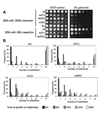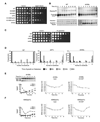Acetylated lysine 56 on histone H3 drives chromatin assembly after repair and signals for the completion of repair
- PMID: 18662539
- PMCID: PMC2610811
- DOI: 10.1016/j.cell.2008.06.035
Acetylated lysine 56 on histone H3 drives chromatin assembly after repair and signals for the completion of repair
Abstract
DNA damage causes checkpoint activation leading to cell cycle arrest and repair, during which the chromatin structure is disrupted. The mechanisms whereby chromatin structure and cell cycle progression are restored after DNA repair are largely unknown. We show that chromatin reassembly following double-strand break (DSB) repair requires the histone chaperone Asf1 and that absence of Asf1 causes cell death, as cells are unable to recover from the DNA damage checkpoint. We find that Asf1 contributes toward chromatin assembly after DSB repair by promoting acetylation of free histone H3 on lysine 56 (K56) via the histone acetyl transferase Rtt109. Mimicking acetylation of K56 bypasses the requirement for Asf1 for chromatin reassembly and checkpoint recovery, whereas mutations that prevent K56 acetylation block chromatin reassembly after repair. These results indicate that restoration of the chromatin following DSB repair is driven by acetylated H3 K56 and that this is a signal for the completion of repair.
Figures







Comment in
-
A histone code for chromatin assembly.Cell. 2008 Jul 25;134(2):206-8. doi: 10.1016/j.cell.2008.07.007. Cell. 2008. PMID: 18662534
References
-
- Adkins MW, Carson JJ, English CM, Ramey CJ, Tyler JK. The histone chaperone anti-silencing function 1 stimulates the acetylation of newly synthesized histone H3 in S-phase. J Biol Chem. 2007;282:1334–1340. - PubMed
-
- Adkins MW, Howar SR, Tyler JK. Chromatin disassembly mediated by the histone chaperone Asf1 is essential for transcriptional activation of the yeast PHO5 and PHO8 genes. Mol Cell. 2004;14:657–666. - PubMed
-
- Aguilera A, Gomez-Gonzalez B. Genome instability: a mechanistic view of its causes and consequences. Nat Rev Genet. 2008;9:204–217. - PubMed
-
- Altaf M, Saksouk N, Cote J. Histone modifications in response to DNA damage. Mutat Res. 2007 - PubMed
-
- Bakkenist CJ, Kastan MB. DNA damage activates ATM through intermolecular autophosphorylation and dimer dissociation. Nature. 2003;421:499–506. - PubMed
Publication types
MeSH terms
Substances
Grants and funding
LinkOut - more resources
Full Text Sources
Other Literature Sources
Molecular Biology Databases

